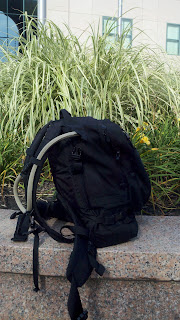 |
| The garden the ducks patrolled. |
So my adventure in backyard egg production began with the best of intentions. Ducks for fun and eggs. I did my research, I looked at Khaki Campbells online, great egg layers, friendly, but they just looked too plain. Then I stumbled upon Indian Runner Ducks - The Jester of the duck kingdom. Sounds simple right? A trip to Dunlap Nursery in Caldwell, Idaho was my next step.
Being a novice to the duck world, I walked in, asked for 5 Indian Runners and a large bag of chick feed. Just one small problem, that took me almost a month to realize, I was the proud papa to 5 gregarious Peking ducks. Another month or so later it also became clear that four out of five of my Pekings were never going to lay eggs - as their lack of quacking confirmed.
Don't get me wrong, the Pekings were fantastic personality wise, friendly and social. But I was dead set on the Indian Runner so I turned to Craigslist. I found a male and female pair for $12 bucks and took them home. Again, more lessons learned. Ducks are social creatures, but this particular male Indian Runner I brought home was very dominant, and even if he was only 3/4 as big as the juvenile Pekings he was running the roost. I'll get back to that story in a later post!
Ducks over chickens, Chevy versus Ford, Stick versus Automatic, it's the age old debate. I'll give you my reasons for choosing ducks. First and foremost I just thought they were hilarious to watch, and I enjoyed their personality as they wandered the backyard. Next the Indian Runner eggs were like clockwork, with Mildred (the Indian Runner) laying an egg almost every day. The eggs are about 25% bigger than chicken eggs, and they are amazing to bake and cook with due to the larger yolk. Finally, the ducks (Pekings and Indian Runners) were great for my garden!
Do you remember Mr. Miyagi in Karate Kid teaching Daniel to catch flies with chopsticks? That was what it was like to watch the ducks grab flies from the air. The ducks terminated each and every slug, fly, and mosquito with extreme prejudice. Another plus over chickens is the ladies did a great job of foraging and feeding themselves while never tearing up my garden.
Cons, that egg that Mildred laid each day turned into a daily Easter Egg hunt everyday when I returned home. Duck eggs cooked by themselves are not chicken eggs, they didn't taste bad, but you knew there was something different going on. The ladies quack, most of the time it's not too obnoxious, but every morning when the sun first peeked up it was as if the ladies had won the lottery. Indian Runners are pretty shy, Mildred was always wary, where Matilda (my Peking) came running up looking for a handout every time I came into the back porch. The final downside, the ladies loved concrete, that wouldn't be a problem if not for that being the material that made up my back porch. Nothing a hose and push broom couldn't remedy in five minutes, but still hard to explain to citified friends...
I'll have to show in another post the simple cheap coop I built for them, it wasn't ideal to over winter them, but during the warm months it allowed me to keep them safe at night and compost there droppings in place. Each week when I mowed the yard I would cover last weeks droppings with saved newspaper, then dump a bag or two of grass in the coop. It worked out fantastically, I never smelled a hint of duck poop wafting through the back yard.
If you're thinking about getting some ducks, do it! You'll have a blast!







